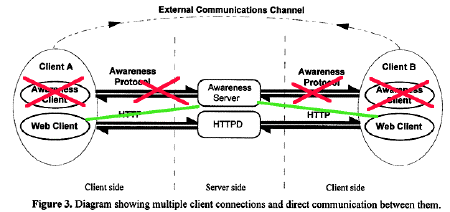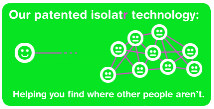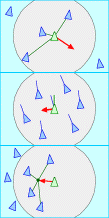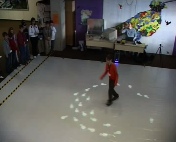![]() Ein System, das die Co-Präsenz von „Mitsurfern“ (also anderen Menschen die auch gerade im Web online sind) zeigt, ist Lluna (hier ein Presseartikel). In einem früheren Posting „Mensch im Web, wo bist Du?“ hab ich Lluna schonmal kurz vorgestellt. Nun hat sich Lluna umbenannt und macht einen Web2.0-adäquaten Neuanfang unter dem Namen Zweitgeist. Wobei das „nun“ etwas zuviel Aktualität heuchelt, denn seit November letzten Jahres ist das laut einer Bekanntmachung auf der Webseite bereits der Fall. Das Gründerportal forward2business hat aber erst kürzlich berichtet über zweitgeist, datiert doch ein Ankündigungseintrag im portal auf den 30. Januar 2007.
Ein System, das die Co-Präsenz von „Mitsurfern“ (also anderen Menschen die auch gerade im Web online sind) zeigt, ist Lluna (hier ein Presseartikel). In einem früheren Posting „Mensch im Web, wo bist Du?“ hab ich Lluna schonmal kurz vorgestellt. Nun hat sich Lluna umbenannt und macht einen Web2.0-adäquaten Neuanfang unter dem Namen Zweitgeist. Wobei das „nun“ etwas zuviel Aktualität heuchelt, denn seit November letzten Jahres ist das laut einer Bekanntmachung auf der Webseite bereits der Fall. Das Gründerportal forward2business hat aber erst kürzlich berichtet über zweitgeist, datiert doch ein Ankündigungseintrag im portal auf den 30. Januar 2007.  Aber scheinbar haben die Macher von zweitgeist seit Lluna ein kleines Manko noch nicht beheben können, ich muss mir erst eine Zusatzsoftware dafür installieren. Itzle – ein ähnlicher Dienst – funktioniert z.B. völlig ohne Zusatzsoftware. Da es die benötigte Software derzeit nur für Windows gibt, scheitert es bei meinem Mac leider genauso wie schon vor einem Jahr, als ich Lluna ausprobieren wollte. Schade. Das Topcloud-Feature finde ich nämlich sehr spannend, das kann man durchaus als Web 2.0 Funktion oder gar als „Präsenz-Sharing“ bezeichnen.
Aber scheinbar haben die Macher von zweitgeist seit Lluna ein kleines Manko noch nicht beheben können, ich muss mir erst eine Zusatzsoftware dafür installieren. Itzle – ein ähnlicher Dienst – funktioniert z.B. völlig ohne Zusatzsoftware. Da es die benötigte Software derzeit nur für Windows gibt, scheitert es bei meinem Mac leider genauso wie schon vor einem Jahr, als ich Lluna ausprobieren wollte. Schade. Das Topcloud-Feature finde ich nämlich sehr spannend, das kann man durchaus als Web 2.0 Funktion oder gar als „Präsenz-Sharing“ bezeichnen.
Offenbar wurde nun ein Geschäftsmodell aus der Idee gemacht, hinter dem neben Seed-Investor Jan Andresen, Christine Stumpf und Dr. Heiner Wolf (die Macher von Lluna) stehen, die auch schon www.webmobs.de aus der Taufe gehoben haben. Finanziert wird das Web2.0 Startup durch den High-Tech Gründerfonds, der mit 500T€ einen Anschub gibt.
Update 8.3.2007
Das Prinzip hinter der Zeitgeist-Software ist übrigens schon relativ alt. Schon 1996 wurde ein Artikel mit dem Titel „A Protocol for User Awareness on the World Wide Web“ veröffentlicht von Kevin Palfreyman und Tom Rodden. Die Schemazeichnung zu dem Funktionsprinzip sieht wie folgt aus:

Funktionsweise des Zweitgeist-Systems soweit ich sie verstanden habe
Mein Vorschlag zur Verbesserung: Man eliminiere den Client, indem man auf die Möglichkeiten zurückgreift, die der Browser bereithält und transportiere die notwendigen Daten über das Standardprotokoll HTTP zu dem Awareness-Server, also so wie in rot und grün von mir markiert.
![]() Update 10.3.2007
Update 10.3.2007
Ein Gegenentwurf zu der vorgestellten Präsenz-Technologie wäre ein konsequent ausgeführte Absenz-Technologie. Tja, und wie das so ist in der Welt, die Idee dazu gibts schon und sie hat einen einprägsamen Namen: Isolatr. Da einem die Gesellschaft ja durch moderne Technologien immer dichter auf den Pelz rückt (sagt da jemand „Handy“?) und Privatheit zum Luxusgut avanciert, ist isolatr vielleicht gar keine so dumme Idee.  Das Logo jedenfalls ist schonmal gelungen, und die FAQ der Seite ist ein Spass zum Lesen. (via pasta&vinegar)
Das Logo jedenfalls ist schonmal gelungen, und die FAQ der Seite ist ein Spass zum Lesen. (via pasta&vinegar)
Etwas möchte ich noch ergänzen: Zweitgeist hat vor wenigen Tagen eine Auszeichnung vom Bundeswirtschaftsministerium bekommen. (Meine innere Stimme sag leise: „Hmm, was sind schon Awards im heftigen Web 2.0 Business.“)
Update 22.3.2007
 Und schon ist zweitgeist auch schon wieder Geschichte… denn jetzt heissen sie international überall aussprechbar Weblin und die Webseiten wurden wie man so schön sagt „relaunched“. Tja, da sieht man wieder wie schnell Web 2.0 ist, da gehören Namensänderungen natürlich in die Dynamik mit hinein.
Und schon ist zweitgeist auch schon wieder Geschichte… denn jetzt heissen sie international überall aussprechbar Weblin und die Webseiten wurden wie man so schön sagt „relaunched“. Tja, da sieht man wieder wie schnell Web 2.0 ist, da gehören Namensänderungen natürlich in die Dynamik mit hinein.
Update 5.4.2007
 Die Zweitgeist GmbH setzt offenbar auf Partnerschaften, für die weitere Marktbearbeitung, neu im Angebot ist eine spezielle Softwareversion des Weblin-Client, der speziell auf den Messenger von Windows Live abgestimmt ist.
Die Zweitgeist GmbH setzt offenbar auf Partnerschaften, für die weitere Marktbearbeitung, neu im Angebot ist eine spezielle Softwareversion des Weblin-Client, der speziell auf den Messenger von Windows Live abgestimmt ist.
Update 17.5.2007
Noch ein Dienst, um endlich allein zu sein: alleinr.de
Why do I blog this? Software, die die Präsenz bzw. Co-Präsenz von Personen im Netz sichtbar macht, und Ihre Auswirkungen ist ein Kerngebiet in meiner Dissertation. Daher finde ich die Entwicklung von Zweitgeist äußerst spannend! Ich hätte da auch einige Ideen…


 Vor ca. einem Jahr gab es an der
Vor ca. einem Jahr gab es an der  Wie das genau aussieht, kann man in folgenden zwei Videos sehen (leider nicht sehr flüssiges Bild, sorry!):
Wie das genau aussieht, kann man in folgenden zwei Videos sehen (leider nicht sehr flüssiges Bild, sorry!):  SecondLife itself is stirring up the blogosphere since LindenLab claimed to have passed the 1 Mio-Users-Milestone. Attention is also drawn to SL by the scientific community, e.g. from the
SecondLife itself is stirring up the blogosphere since LindenLab claimed to have passed the 1 Mio-Users-Milestone. Attention is also drawn to SL by the scientific community, e.g. from the